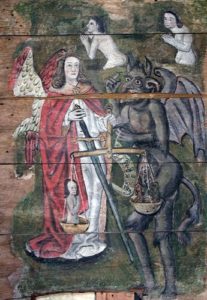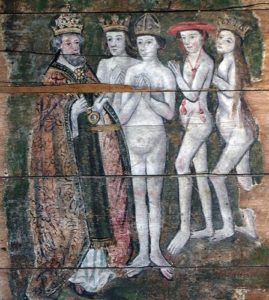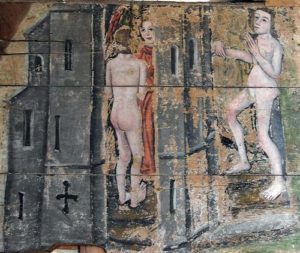We made the mistake of approaching the church from the north, using the entrance off the main street. Seen from this side, the church looks scruffy with rendered plaster beginning to peel off and in need of painting. We were wondering what we were letting ourselves in for. The better access is to the south, off Church Lane, with the attractive flint built nave.
There has been a church here since Saxon times when it was under the patronage of Blythburgh Priory. Most of the present building dates from the 14th/15thC. The church suffered badly under the Parliamentarians and William Dowsing. Windows were smashed, angels removed from the roof, the organ, altar and pulpit removed.
From the outside it is a fairly plain building with simple square tower, with flushwork buttresses, long low nave and chancel. On the north side is an aisle under the same roof as the nave. The south porch with a decorative frieze above the doorway. There is a stoup by the door and a sanctuary knocker. Steps lead down into the porch and nave.
Immediately inside the door on the right is a lovely carved wood panel which may have been part of a pew.
Directly opposite the door, propped up on the north wall is the highlight of the church and what everyone comes to see; a magnificent doom painting. This is painted on wood and was originally filled the top of the chancel arch. It is thought to date from 1400 and have been made by a monk from Blythburgh. The crucifix of the rood with the statues of the Virgin Mary and St John were originally attached to the painting and the outlines can still be seen. The painting was covered with whitewash and boxed over during the reign of Edward VI. The Royal Coat of Arms was hung in front of it. It escaped the attentions of the Parliamentarians and William Dowsing. It was rediscovered during the 19thC restoration of the church. Workmen ripped out the woodwork and left it in the churchyard to be reused later. It rained heavily overnight and the whitewash was washed off revealing the painting.
At the top left is the figure of Christ sitting on a rainbow. To the right are Mary and John the Baptist saying intercessionory prayers for the dead. Below them is St Michael in white robe and red cloak and a black devil weighing the souls of the dead. To their right is the mouth of Hell with damned souls being herded into it by devils. On the left is St Peter in pontifical vestments and crown. He holds the key of Heaven and is welcoming the saved. The four naked figures include a king, pope, cardinal and a queen. Beyond St Peter is Heaven with a figure at the door and another climbing the stairs.
Beneath is painted a later text from Romans 13 1-4. “Let every soule submit him selfe unto the authorytye of the hygher powers for there is no power but of God the Powers that be are ordeyend of God, but they that rest or are againste the ordinaunce of God shall receyve to them selves utter damnacion. For rulers are not fearefull to them that do good But to them that do evyll for he is the mynister of God.”
The walls and ceiling are whitewashed. There is a simple beamed ceiling in the nave. There are slender octagonal pillars with pointed arches separating nave and north aisle.
At the back of the nave is a simple octagonal font. There is a Royal Coat of Arms and a Charities Estate Board. The pews have been removed and replaced with chairs.
The chancel arch now has a beautifully carved wooden inset supported on stone corbels with St Peter holding a key on the left. The pulpit in front of the arch is Jacobean with carved arches and flower motifs. Angels support the book rest which still has candlesticks.
The chancel has a wood panelled roof with wood ribs with carved bosses and a carved frieze round the base. The carved choir stalls have carved poppyheads. A simple altar sits under the 19thC stained glass window which has elaborate marble memorials on either side. The genealogy gets a bit complicated. On the left it is recorded that Philippa Leman d 1757 is interred in the same vault as her brother Thomas Leman. The monument lists grandparents, parents and siblings. On the opposite side is the memorial to another brother, Neville who was interred with Eliza, daughter of his brother Thomas…
In many ways this is an unexciting church apart from the magnificent Doom painting which must surely rank among the best in England. It is worth visiting just for this.
The church is open daily and there is plenty of parking by the village hall and post office opposite the church.










